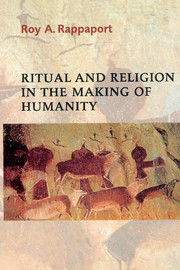Book contents
- Frontmatter
- Contents
- Foreword
- Preface
- 1 Introduction
- 2 The ritual form
- 3 Self-referential messages
- 4 Enactments of meaning
- 5 Word and act, form and substance
- 6 Time and liturgical order
- 7 Intervals, eternity, and communitas
- 8 Simultaneity and hierarchy
- 9 The idea of the sacred
- 10 Sanctification
- 11 Truth and order
- 12 The numinous, the Holy, and the divine
- 13 Religion in adaptation
- 14 The breaking of the Holy and its salvation
- Notes
- References
- Index
- Cambridge Studies in Social and Cultural Anthropology
8 - Simultaneity and hierarchy
Published online by Cambridge University Press: 05 June 2012
- Frontmatter
- Contents
- Foreword
- Preface
- 1 Introduction
- 2 The ritual form
- 3 Self-referential messages
- 4 Enactments of meaning
- 5 Word and act, form and substance
- 6 Time and liturgical order
- 7 Intervals, eternity, and communitas
- 8 Simultaneity and hierarchy
- 9 The idea of the sacred
- 10 Sanctification
- 11 Truth and order
- 12 The numinous, the Holy, and the divine
- 13 Religion in adaptation
- 14 The breaking of the Holy and its salvation
- Notes
- References
- Index
- Cambridge Studies in Social and Cultural Anthropology
Summary
At the beginning of chapter 6 I suggested that liturgies, in an analogy to chambers, are realized in what may be taken to be three dimensions. Chapter 6 was itself devoted to the sequential dimension, the most obviously temporal of the three, the one that can be likened to the length of the chamber or, more dynamically, to striding the length of that chamber and, in the course of that procession, organizing time or, more properly, temporality. Consideration of the division of unmarked duration into the periods constituting mundane time led, in chapter 7, to a discussion of the intervals separating mundane periods and to the temporal condition and states of consciousness and society prevailing in those intervals, and thus to the generation within them of eternity.
We have, at the same time, been led to what I shall call the simultaneous dimension of synchronic liturgical orders. I deliberately avoid the term “synchronic,” reserving it for a general mode of analysis whereas here I am concerned not with a mode of analysis from which temporality has been eliminated but perception.
I have argued that the significance or meaning of any liturgical order in some degree unfolds as one thing follows another in fixed order, but only in some degree. At any, if not every, moment during the sequence's unfolding, participants may face a multiplicity of significata embedded in one or more representations perceived simultaneously.
- Type
- Chapter
- Information
- Ritual and Religion in the Making of Humanity , pp. 236 - 276Publisher: Cambridge University PressPrint publication year: 1999



